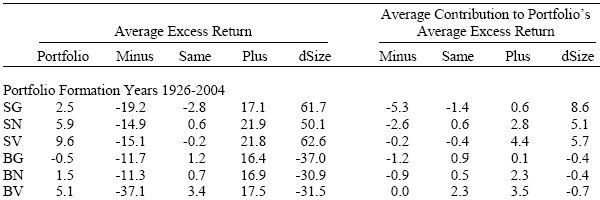As companies evolve, their characteristics may migrate from one category to another (for example, from small to large, or from growth to value). Does such migration, in aggregate, help explain differences in average returns for different categories of stocks? In the August 2006 draft of their paper entitled “Migration”, Eugene Fama and Kenneth French investigate how migration of firms across categories contributes to the size effect and the value premium. Specifically, at the end of each June from 1926 through 2004 they construct six value-weighted portfolios of stocks from the major U.S. exchanges based on market capitalization and price-to-book ratio. They then examine the effects on portfolio returns of four kinds of annual rebalancing actions: (1) firms that do not move (Same); (2) firms that change size (dSize); (3) firms that improve toward growth, or are acquired (Plus); and, (4) firms that deteriorate toward value, or are delisted (Minus). Using subsequent-year return data for 1927-2005, they conclude that:
- The size premium in average returns for 1927-2005 comes almost entirely from the 50%+ average excess returns of the 9-12% of small stocks that become big from one year to the next.
- Big stocks that become small have very negative average excess returns, but they represent only tiny fractions of the market capitalization of big stock portfolios. Stocks that improve toward growth have high average excess returns but make similar contributions to small and big stock portfolios.
- The value premium has three sources: (1) high returns on value stocks that improve toward growth (contributing about 3.5% per year to value portfolios); (2) low returns on growth stocks that deteriorate toward value (contributing 5.1% per year to the small stock value portfolio and 1.2% to the big stock value portfolio); and, (3) slightly higher returns for value stocks than growth stocks that remain in the same portfolio from year to year (contributing about 1% to the value portfolios).
- Migration from small to big stocks add 2.9% per year to the average return on the small growth stocks and therefore work against the value premium.
The following table (extracted from the paper) shows the average excess return of each of the six value-weighted portfolios, and each of the four migration groups within each portfolio, relative to the overall stock market. The portfolio symbols are: S=small, B=big, G=growth, N=neutral and V=value. The portfolio excess returns confirm both the size effect and the value premium, with SV offering the largest average excess return.
In the section on the right, the table shows the contribution of the migration group excess returns to the excess return of each portfolio (taking into account the migration frequencies and market capitalization impacts). For example, Big-Value firms that become more value-like (Minus) have very negative excess returns, but such changes are so rare that they do not significantly affect the return of the Big-Value portfolio.

In summary, as a corollary to mean reversion of firm profitability, asymmetries in small-big and value-growth stock migrations drive the size effect and the value premium.